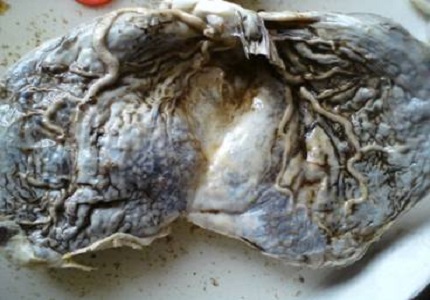Study of arterial pattern of normal human placenta in reference to its shape, weight and Hyrtl’s Anastomosis
Abstract
Background: Study of placenta in reference to its blood supply is very important for the reason that it is highly vascular organ which directly influences the growth and development of foetus. The shape of placenta, its weight together with Hyrtl’s anastomosis also directly or indirectly affects the health and wellbeing of the foetus.
Material & Method: 104 placentae were collected from Labour room, Gynaecology & Obstetrics Department and Lady Loyal Hospital. After cleaning and morphometry, Barium Sulphate was injected in the vascular tree of the placentae. Finally after radiography, observations were recorded.
Results: dispersed pattern of Arterial pattern was found in 72.88 percent placentae and in remaining 27.11 percent, Magestrial pattern was present. Average weight of placentae in the study was 468.4 gm. Hyrtl’s anastomosis was present in 100 out of 104 placentae.
Conclusion: study of vasculature of Placentae revealed that percentage of dispersed and magestrial pattern of placentae in north Indian population is not same as that reported in other studies of different regions.
Downloads
References
Verma, R.; Prasad, R.; Mishra, S. & Kaul, J. M. Vascular pattern of chorionic blood vessels of placenta and its correlation with the birth weight of neonate. Int. J. Morphol. 2012;30(3):952-955.
van den Broek N, Ntonya C, Kayira E, White S, Neilson JP. Preterm birth in rural Malawi: high incidence in ultrasound-dated population. Hum Reprod. 2005 Nov;20(11):3235-7. Epub 2005 Jul 21.
Kouvalainen K, Pynnönen AL, Mäkäräinen M, Peltonen T. [Weights of placenta, fetal membranes and umbilical cord]. Duodecim. 1971;87(17):1210-4.
Salmani D, Purushothaman S, Somashekara SC, Gnanagurudasan E, Sumangaladevi K, Harikishan R, Venkateshwarareddy M. Study of structural changes in placenta in pregnancy-induced hypertension. J Nat Sci Biol Med. 2014 Jul;5(2):352-5. doi: https://dx.doi.org/10.4103%2F0976-9668.136182.
Patel J, Patel B, Dave R, Ram S, Bhojek N, desai J; A study of placental vascular pattern by corrosive cast in Gujarat region; NJRM 2014;5(1) : 64-71.
Sadler TW. Langman’s medical embryology. 9th Edition.Baltimore,MD:Lippencott Williams and Wilkins2004; 148-178.
Tongsong T, Boonyanurak P. Placental thickness in the first half of pregnancy. J Clin Ultrasound. 2004 Jun;32(5):231-4.
Benirschke K, K.P., Architecture of Normal Villous Trees, Chapter 7, in Pathology of the Human Placenta., Springer Verlag: New York, New York. 2002 p. 116-154.
M. Yampolsky, Placental characteristics and birthweight. Paediatr Perinat Epidemiol. 1998 May; 22(3):229–39.
Kaplan, C Color Atlas of Gross Placental Pathology, New York, Igaku-Shoin, 1994:20-42.
Barker DJ, Bull AR, Osmond C, Simmonds SJ. Fetal and placental size and risk of hypertension in adult life. BMJ 1990 Aug;301:259-62.
Naeye RL. Do placental weights have clinical significance? Hum Pathol 1987 April;18:387-91.
Fraser, J. Amer. J. Obstet. Gynaec. 1923; 4:645-655.
Bacsich P.and Smout C.F.V. some observations of the fetal vessels. J. Anatomy 1938; 72:358. [PubMed]
Shordania, J. Arch. Gynak. (1929) 135: 568. doi: https://doi.org/10.1007/BF01702300.
Ullberg U, Sandstedt B, Lingman G. Hyrtl's anastomosis, the only connection between the two umbilical arteries. A study in full term placentas from AGA infants with normal umbilical artery blood flow. Acta Obstet Gynecol Scand. 2001 Jan;80(1):1-6.
PRIMAN J. A note on the anastomosis of the umbilical arteries. Anat Rec. 1959 May;134:1-5.
Young A. The primate umbilical cord with special reference to the transverse communicating artery. J Hum Evol 1972; 1: 345–359.
Spanner, R. Z. Anat. Entwickl. Gesch. (1935) 105: 163. doi: https://doi.org/10.1007/BF02118325.
ROMNEY SL, REID DE. Observations on the fetal aspects of placental circulation. Am J Obstet Gynecol. 1951 Jan;61(1):83-98.
Crawford JM (1962). Vascular anatomy of the human placenta. Am J of Obstet. Gynecol. 84: 1543–1567.
G. Ragunath and Vijayalakshmi A study of morphology of human placenta,J. of clinical and diagnostic research 2011; vol.5,282-286.
Bleker OP, Wolf H, Oosting J.. The pla¬cental cause of fetal growth retardation in twin gestations. Acta Genet Med Gemellol (Roma). 1995; 44(2):103–6.
Perry IJ, Beevers DG, Whincup PH, Bareford D. Predictors of ratio of placental weight to fetal weight in multiethnic community. BMJ. 1995 Feb 18;310(6977):436-9.
Adinma JI, Agbai AO. Foetal birth weight in Africa. J Obstet Gynaecol 1995; 15:295-297.
Little RE, Zadorozhnaja TD, Hulchiy OP, Mendel NA, Shkyryak-Nyzhnyk ZA, Chyslovska N, Gladen BC. Placental weight and its ratio to birthweight in a Ukrainian city. Early Hum Dev. 2003 Apr;71(2):117-27.
Asha, V.K., Meera, P. Study of placental pathology in toxaemias of pregnancy and its foetal importance. India J. Pathol. Microbial, 1981;24: 245:251.
Yao AC, Moinian M, Lind J. Distribution of blood between infant and placenta after birth. Lancet. 1969 Oct 25;2(7626):871-3.
Leary SD, Godfrey KM, Greenaway LJ, Davill VA, Fall CH. Contribution of the umbilical cord and membranes to untrimmed placental weight. Placenta. 2003 Feb-Mar;24(2-3):276-8.
Panti AA, Ekele BA, Nwobodo EI, Yakubu A. The relationship between the weight of the placenta and birth weight of the neonate in a Nigerian Hospital. Niger Med J 2012;53:80-4.
Heinonen S, Taipale P, Saarikoski S. Weights of placentae from small-for-gestational age infants revisited. Placenta. 2001 May;22(5):399-404.
Kloosterman GJ. Intrauterine growth: The significance of prenatal care. Int J Gynaecol Obstet 1970;8:895-912.
Baergen RN. The placenta as witness. Clin Perinatol. 2007 Sep;34(3):393-407.



 OAI - Open Archives Initiative
OAI - Open Archives Initiative


